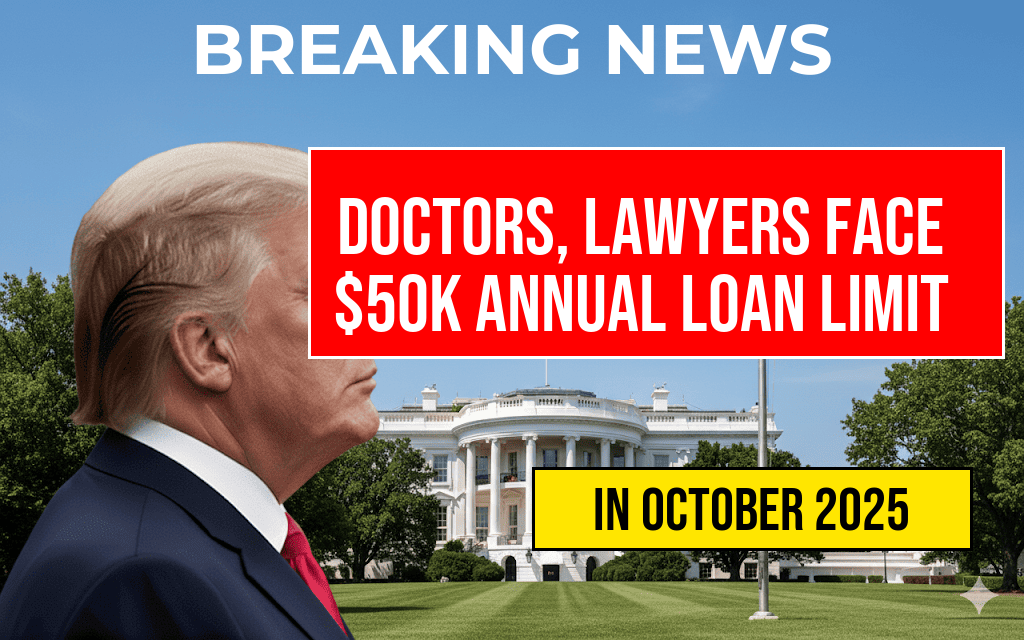Federal Loan Limits Set for Medical and Legal Professionals Amid Rising Debts
A new regulation announced by federal authorities establishes annual loan repayment caps for doctors and lawyers, aiming to curb mounting student debt burdens. Starting immediately, medical professionals and attorneys will be restricted to borrowing a maximum of $50,000 per year, with the cumulative limit reaching $200,000 by 2026. The policy, part of a broader effort to address student loan inflation, targets high-earning fields where debt levels have soared in recent years. The initiative balances the need to support essential public services with fiscal responsibility, drawing both praise and criticism from industry groups and advocacy organizations.
The new limits will affect both new and existing student loans, with some professionals expressing concern over potential constraints on career flexibility. The regulations will be phased in over the next three years, giving practitioners time to adjust their financial planning. The policy aims to promote sustainable borrowing practices while ensuring that healthcare providers and legal experts can still access necessary education funding. Critics argue that the caps may hinder access to advanced training and specialized education, especially in high-cost urban markets.
Details of the New Loan Restrictions
The federal government’s Office of Student Assistance announced the caps as part of a comprehensive strategy to manage the rising costs associated with professional education. Under the new rules, borrowers in medicine and law will be limited to annual borrowing levels of $50,000. The total borrowing limit will escalate gradually, reaching a maximum of $200,000 by the year 2026. These thresholds will apply across federal student loan programs, including Direct Loans and Perkins Loans.
The phased implementation means that:
- In 2024, the annual cap will be set at $50,000.
- In 2025, the cap remains at $50,000.
- By 2026, the annual limit will stay at $50,000 but with a cap on total borrowing at $200,000.
The policy also encourages repayment plans based on income, aiming to prevent practitioners from accumulating unmanageable debt loads that could impact service delivery in underserved communities.
Rationale Behind the Policy
Officials argue that the restrictions are necessary to promote responsible borrowing and prevent future debt crises in professions vital to public welfare. The rising costs of law school and medical education have led to average debt levels exceeding $200,000 for many graduates, complicating career choices and financial stability.
“By capping annual and total borrowing, we aim to ensure that professionals can serve their communities without being overwhelmed by debt,” said a Department of Education spokesperson. “This approach encourages prudent financial planning and sustainable career development.”
Legal and medical associations have responded with mixed reactions. Some see the caps as a positive step toward debt management, while others warn that the restrictions could limit access to specialized training and deter prospective students from pursuing these careers.
Implications for Future Borrowers and Industry Sectors
The new rules are poised to reshape how students in medicine and law approach their education financing. Financial advisors suggest that prospective students should now prioritize scholarship opportunities and alternative funding sources to offset potential borrowing limits.
| Year | Annual Loan Limit | Cumulative Loan Limit |
|---|---|---|
| 2024 | $50,000 | Unchanged, subject to individual borrowing |
| 2025 | $50,000 | Unchanged, with ongoing limits |
| 2026 | $50,000 | $200,000 |
The policy also signals a shift toward more regulated lending practices in high-cost fields, with some states considering supplementary programs to fill funding gaps. For example, jurisdictions like California and New York are exploring state-backed loan programs aimed at supporting students who may be affected by federal limits.
Meanwhile, medical schools and law schools are reassessing their financial aid strategies to accommodate these changes, emphasizing scholarship programs and alternative funding sources to maintain diversity and accessibility.
Industry and Advocacy Responses
Representatives from the American Medical Association and the American Bar Association have issued statements expressing cautious optimism. AMA President Dr. Lisa Reynolds noted, “While the caps may help prevent future debt crises, we must ensure they do not inadvertently restrict access to necessary training or discourage prospective students from underserved backgrounds.”
Legal advocacy groups have raised concerns that the limits could disproportionately impact students from lower-income families, potentially reducing diversity within the professions. Some experts suggest that targeted loan forgiveness programs or income-based repayment options could complement the new caps to mitigate these effects.
The policy’s success will depend on how well implementation balances financial responsibility with access and professional development opportunities.
Looking Ahead
As the federal government enforces these new limits, stakeholders across the healthcare and legal sectors will monitor their impact closely. The policy reflects a broader effort to align educational financing with economic realities, emphasizing sustainability and fiscal discipline.
For more information on federal student loan policies and repayment options, visit the Department of Education’s official site studentaid.gov. Additionally, resources outlining the typical costs of medical and legal education can be found on Wikipedia’s pages on medical education and law school.
Frequently Asked Questions
What is the new annual federal loan limit for doctors and lawyers?
The annual federal loan limit for doctors and lawyers will be set at $50,000 starting soon, with a maximum of $200,000 by 2026.
When will the new loan limits take effect?
The federal loan limits for doctors and lawyers are scheduled to be implemented gradually, reaching the $200,000 cap by 2026.
How will the new loan limits impact medical and legal professionals?
The new limits are designed to reduce debt burdens for medical and legal professionals by capping the amount they can borrow annually and overall by 2026.
Are there any exceptions to these loan limits for certain professions?
Currently, the federal loan limits apply generally to doctors and lawyers, with no specific exceptions announced, but policies may evolve.
What are the reasons behind implementing these loan limits?
The government aims to manage student debt more effectively and ensure federal funds are allocated fairly, especially for professional students like doctors and lawyers.










